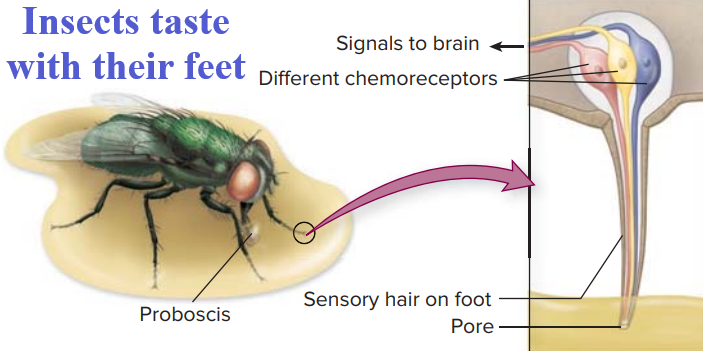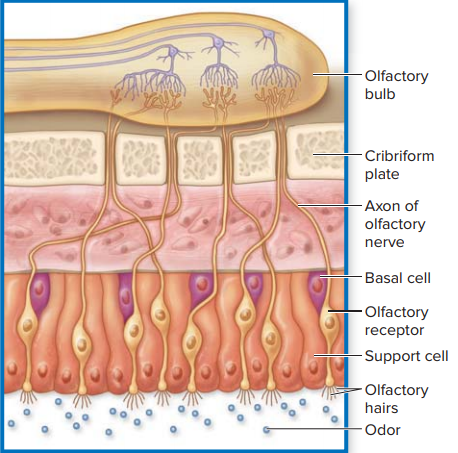The Science and Principle of Taste, Smell, and pH

The Science and Principle of Taste, Smell, and pH
Some sensory cells, called chemoreceptors, contain membrane proteins that can bind to particular chemicals or ligands in the extracellular fluid.
In response to this chemical interaction, the membrane of the sensory neuron becomes depolarized and produces action potentials.
Chemoreceptors are used in the senses of taste and smell and are also important in monitoring the chemical composition of the blood and cerebrospinal fluid.
Taste Detection Mechanism
The perception of taste (gustation), like the perception of colour, is a combination of physical and psychological factors.
This is commonly broken down into five categories:
- sweet,
- sour,
- salty,
- bitter,
- umami (perception of glutamate and other amino acids that give a hearty taste to many protein-rich foods such as meat, cheese, and broths).
Taste Buds
Collections of chemo-sensitive epithelial cells associated with afferent neurons mediate the sense of taste in vertebrates.
In a fish, the taste buds are scattered over the surface of the body.
These are the most sensitive vertebrate chemoreceptors known.
They are particularly sensitive to amino acids; a catfish, for example, can distinguish between two different amino acids at a concentration of less than 100 parts per billion.
The ability to taste the surrounding water is very important to bottom-feeding fish, enabling them to sense the presence of food in an often murky environment.
The taste buds of all terrestrial vertebrates occur in the epithelium of the tongue and oral cavity, within raised areas called papillae.
Taste buds are onion-shaped structures of between 50 and 100 taste cells;
Each cell has finger-like projections called microvilli that poke through the top of the taste bud, called the taste pore.
Chemicals from food dissolve in saliva and contact the taste cells through the taste pore.
Within a taste bud, the chemicals that produce salty and sour tastes act directly through ion channels.
The prototypical salty taste is due to Na+ ions, which diffuse through Na+ channels into cells in receptor cells in the taste bud.
This Na+ influx depolarizes the membrane, causing the receptor cell to release neurotransmitters and activate a sensory neuron that sends an impulse to the brain.
The cells that similarly detect sour taste act except that the ion detected is H+.
Sour tastes are associated with an increased concentration of protons that can also depolarize the membrane when they diffuse through ion channels.
- Memory and Learning. Mechanism of Alzheimer’s Disease Still a Mystery?
- Mechanism of Sleep and Language and Spatial Recognition.
- What Predicts Student Achievement
Sweet, Bitter, and Umami;
- Substances bind to G protein-coupled receptors specific for each category.
- This leads to cells that have receptors for sweet, bitter, or umami tastes.
- Activation of any of these G protein-coupled receptors then stimulates a single signalling pathway that leads to the release of neurotransmitters from receptor cells to activate a sensory neuron and send an impulse to the brain.
- There they interact with other sensory neurons carrying information related to smell, as described next.
- In this model, the different tastes are encoded to the brain based on which receptor cells are activated.
- Like vertebrates, many arthropods also have taste chemoreceptors.
- For example, flies, because of their mode of searching for food, have taste receptors in sensory hairs located on their feet.
- The sensory hairs contain a variety of chemoreceptors that can detect sugars, salts, and other tastes by the integration of stimuli from these chemoreceptors.

If they step on potential food, their proboscis (the tubular feeding apparatus) extends to feed.
Mechanism of Smell
- In terrestrial vertebrates, the sense of smell (olfaction) involves chemoreceptors located in the upper portion of the nasal passages.
- These receptors, whose dendrites end in tassels of cilia, project into the nasal mucosa, and their axons project directly into the cerebral cortex.
- A terrestrial vertebrate uses its sense of smell in much the same way that a fish uses its sense of taste to sample the chemical environment around it.
- Because terrestrial vertebrates are surrounded by air, their sense of smell has become specialized to detect airborne particles but these particles must first dissolve in extracellular fluid before they can activate the olfactory receptors.
- The sense of smell can be extremely acute in many mammals, so much so that a single odorant molecule may be all that is needed to excite a given receptor.
Although humans can detect only five modalities of taste, they can discern thousands of different smells.

Detection of pH and Other Characteristics
- Sensory receptors within the body detect a variety of chemical characteristics of the blood or fluids derived from the blood, including cerebrospinal fluid.
- Included among these receptors are the peripheral chemoreceptors of the aortic and carotid bodies, which are sensitive primarily to plasma pH, and the central chemoreceptors in the medulla oblongata of the brain, which are sensitive to the pH of cerebrospinal fluid.
- When the breathing rate is too low, the concentration of plasma CO2 increases, producing more carbonic acid and causing a fall in the blood pH.
- The carbon dioxide can also enter the cerebrospinal fluid and lower the pH, thereby stimulating the central chemoreceptors.
- This stimulation indirectly affects the respiratory control center of the brainstem, which increases the breathing rate.
- The aortic bodies can also respond to a lowering of blood oxygen concentrations, but this effect is normally not significant unless a person goes to a high altitude where the partial pressure of oxygen is lower.
Join Enlighten Knowledge WhatsApp platform.
Join Enlighten Knowledge Telegram platform.





